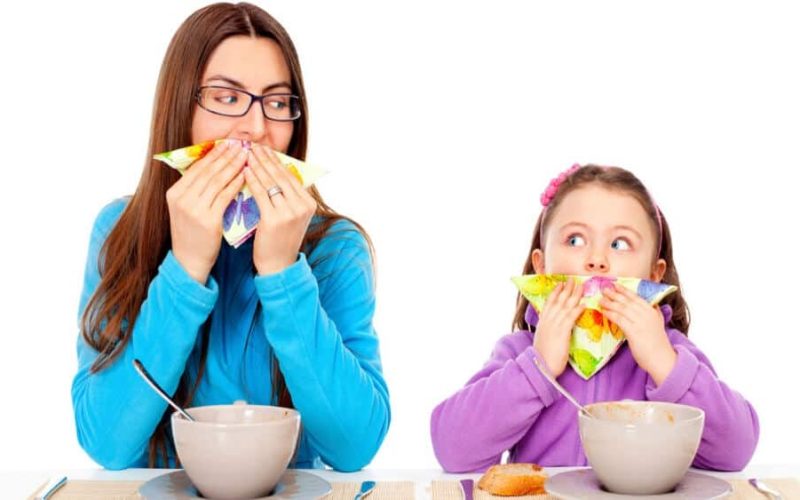Have your kids ever done something during a meal that made you cringe? Then this post is for you. Every parent has had moments or moments when children did not put their best behavior at the table.
Life is an unending learning process. As kids grow, they depend on their caregivers to teach and train them in all aspects of life.
Teaching children table etiquette is as essential as potty training, vocabulary coaching, and any other training they undergo.
Begin training your kids how to behave at the table as early as possible. While it may be hard for a one-year-old to grasp some basics, there’s always something to learn at every age.
Mealtimes are special moments for most families. The need for proper etiquette cannot be over-emphasized.
There are different approaches to teaching kids about family mealtime etiquette.
Helpful Tips for Parents to Use in Teaching Table Manners to Kids
Ensure Your Hands and Face Are Clean
This cleanliness applies to all children, whether they wash themselves or need help. Kids old enough to secure a place at the dinner table can clean their faces and hands.
Train your little ones to pass by the sink and do what is necessary before they can settle for family meals.
In the morning, the face is dirty from all the last night’s drooling and eye crust. That is not a sight to behold for other table users. Washing hands is the most basic of all the table manners practices.
The kids will be sharing food and utensils with other users, and it’s essential to have clean hands for hygiene’s sake.
Be Patient for Everyone to Serve
While this is a good practice, it may not apply to all ages. Younger children may be allowed to start eating after they are served. If they are starving, waiting will not be an option for them.
Allow them to sample finger foods as the rest of the family serves. Older children can wait until everyone settles.
Waiting for one another enhances the table dining experience. However, sometimes people may arrive at the table at different times. In such a case, parents can let their children eat.
Table rules are not cast in stone. Some necessary exceptions are allowed.
Serve Enough, Not Too Much
One of the basics of table manners is not serving more than you can handle. Everyone has a favorite dish that makes them want to over-indulge.
Teach your children the need for self-restraint during family meals and always. Let them serve reasonable portions first, and then they can add more once they clear their plates.
Serving too much food is not only bad manners but also wasteful. Clearing your plate shows that you appreciate the host and value the food.
Having good table manners to serve enough while keeping the other diners in mind is also good. If one person serves too much, others may not taste some dishes.
Swallow Before You Talk
Holding a meaningful conversation during family meals leads to a great table dining experience.
However, talking with food in the mouth is unacceptable. Let them cover their mouth if one has to say something before swallowing.
Teach your children to avoid talking with food in their mouths. The sight of chewed food is unpleasant, and choking is also a risk. It is easier for older children to grasp and follow this table rule than for toddlers.
You will need the patience to train a two-year-old on this, but it’s doable.
Do Not Slurp!
This issue is not exclusive to children. Some adults make annoying sounds as they eat or drink. From a tender age, train your kids to chew and sip dignifiedly.
Producing irritating sounds during family meals will spoil it for the dinners. Teach your children to practice good table manners, whether alone or with others. Chewing is an art that needs to be perfected over time.
Kids should practice table manners at home or in school, especially how they chew.
‘Please Pass Over the Salt’
That’s the way to go about it. Walking from one side of the table to the other to pick something distracts the other diners. Passing your hands over someone’s food is worse.
Teach your children to ask for something they need instead of struggling to get it themselves.
To avoid commotion during family dinners, train your kids to get whatever they need before settling down.
If they need to add something to their plate and it is not conveniently placed, let them ask for help. This way, they avoid unnecessary spillage.
Compliment, Not Complain
Children can be brutally honest at times. To avoid awkward moments, teach your kids to complement rather than complain.
Complaining is unacceptable if a child does not like what is on the table. Bad comments about food are never taken kindly, especially if you’re away from home.
If your kids are picky, serve them whatever they prefer and leave the unfamiliar foods.
It is good manners for kids to focus on the positive and compliment the host for it without mentioning the not-so-great. If they enjoyed one of their favorite dishes, let them appreciate the host for making a great meal.
Keep Your Elbows Off the Table
The dining table is meant for food, unused napkins, and utensils. Teach your little ones to sit upright with their elbows away from where the food is.
This way, they will minimize accidents during mealtimes. It is easy for you to push something off the table with your elbow, and you don’t want your children to create such a mess.
One way to keep elbows away is by providing sizable chairs for the children. This way, they can sit comfortably and in the proper posture. Only the forearms are allowed on the table during family mealtime.
Say Thank You For the Meal
Whether away from home or during family meals, train your children to show gratitude for a meal. A lot goes into preparing and serving a meal, and showing appreciation after a meal is basic table manners.
Even if they do not like something, saying thank you goes a long way. Another way of showing gratitude is by helping with what they can manage.
If your child is old enough to clear and wipe the surfaces, let them do so. It is messy to leave used napkins, dirty utensils, and food particles on the dinner table.
Teaching table manners to kids should be a continuous process for any parent who cares about etiquette. By the time a child reaches the 3-year mark, they should know how to place a napkin on their lap before eating.








